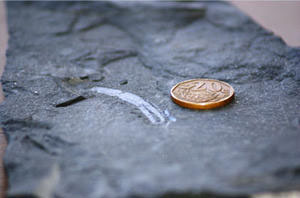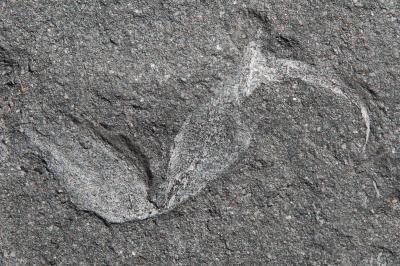A tourist to the south eastern tip of what was to become the continent of Africa 350 million years ago would have had to watch where they were treading as scorpions were lurking amongst the primitive plants. We know this because Dr Robert Gess from the Evolutionary Studies Institute at the University of Witswatersrand (Johannesburg), has discovered the fossilised exoskeleton of one such creature. This unique specimen, a new species named Gondwanascorpio emzantsiensis represents the oldest known terrestrial animal from the super-continent of Gondwana discovered to date.
Gondwanascorpio emzantsiensis
Fossils of terrestrial animals are known from the super-continent of Laurasia, but this is a first for the ancient landmass that dominated the Southern Hemisphere during the Late Devonian and into the Carboniferous.
A Photograph showing the Scorpion’s Pincers (Gondwanascorpio emzantsiensis)
Picture credit: University of Witwatersrand
Oldest Known Terrestrial Animal
Commenting on his fossil find, Dr Gess stated that early life arose in the sea and that colonisation of the land took place much later on in the history of life on Earth. This process is believed to have begun back in the Silurian geological period, approximately 420 million years ago, although some palaeobotanists have suggested that microscopic spores preserved in Ordovician strata indicate that plant life was established on land even earlier.
Once plants had become established on land in significant numbers, then detritus and plant eating invertebrates followed, animals such as primitive arthropods. By the Late Silurian, around 415 million years ago, terrestrial food chains were much more complex with apex predators such as mites, scorpions and early spiders feeding on the herbivorous invertebrates. By the Late Devonian, some 365 million years ago, the first vertebrates (tetrapods) had ventured out onto land.
The First Tetrapods
Some palaeontologists believe that the first vertebrates were established on land some 390 million years ago, click the link below to read an article published by Everything Dinosaur in 2010, that provides details of a remarkable fossilised trackway studied by Polish scientists: Tetrapods Venture onto Land Thirty-Five Million Years Earlier.
Fossils found in Palaeozoic strata that represent the land mass of Laurasia, a super-continent the straddled much of the northern hemisphere in the Devonian, suggest that this landmass was inhabited by a diverse and abundant group of invertebrates. Laurasia and Gondwana were separated by an ocean over a thousand miles across at its widest extent.
Evidence of the earliest colonisation of land animals has until now come only from the Northern Hemisphere continent of Laurasia (land that was to form North America, parts of Europe and Asia), and there has been no evidence that Gondwana was inhabited by land living invertebrate animals at that time, however, the discovery of this Southern Hemisphere scorpion suggests that Gondwana too, had its fair share of creepy crawlies.
An Invertebrate Predator on Land
The discovery of an invertebrate predator leads to the assumption that there were other invertebrates present that this creature would have fed upon. This new species has been named Gondwanascorpio emzantsiensis.
Dr Gess stated:
“For the first time we know for certain that not just scorpions, but whatever they were preying on were already present in the Devonian. We now know that by the end the Devonian period Gondwana also, like Laurasia, had a complex terrestrial ecosystem, comprising invertebrates and plants which had all the elements to sustain terrestrial vertebrate life that emerged around this time or slightly later.”
The Witpoort Formation
The fossil fragments were found in black carbonaceous shale which represents a marine lagoon and an estuarine environment. The fossiliferous material is from the Witpoort Formation (Witteberg Group) at a location known as Waterloo Farm, near Grahamstown, South Africa. Other organic material identified includes traces of algae, terrestrial plants, small fish, a sea scorpion (Eurypterid) and a number of molluscs. All the fossil material ascribed to G. emzantsiensis consists of two-dimensional compressions in which all the original organic material has been replaced by secondary metamorphic mica. The mica has largely been altered to chlorite during the uplifting of the strata. The Witpoort Formation strata at the Waterloo Farm location were laid down towards the end of the Devonian (Famennian faunal stage), approximately 360 million years ago.
A Close up of the Preserved Pincers
Picture credit: University of Witwatersrand
The Discovery of a Palaeozoic Scorpion
The fossil material represents the first discovery of a Palaeozoic scorpion from Gondwana. In the scientific paper, published in the academic journal “African Invertebrate”, the researchers note that this fossil find is extremely unusual as it comes from rocks deposited at a far higher latitude (much closer to the South Pole), than that at which extant or fossil scorpions are known to have occurred. The authors suggest that this discovery may suggest that the climate in the southern hemisphere during the Late Devonian was much more uniform than it is today. Temperatures at high latitudes may have been much higher than they are today.
Gondwanascorpio emzantsiensis Possessed a Powerful Sting
Picture credit: University of Witwatersrand
Devonian Ecosystems
The scientists report that the presence of this scorpion from Gondwana, one that is similar to already described Laurasian taxa is consistent with the growing body of evidence that suggests globally comparable terrestrial ecosystems by the end of the Devonian. Gondwanascorpio, as the oldest terrestrial animal from Gondwana and its fossil material along with progymnosperm plant material (Archaeopteris) that has also been described from fossils found at Waterloo Farm, suggests that marine marginal ecosystems may have been very similar across the world during the Late Devonian. It has been speculated that this uniformity may have been a consequence of the increasing proximity of Laurasia to Gondwana as the deep ocean that once separated these super-continents began to close up.
The Location of the Waterloo Farm Site Mapped onto a Late Devonian Map of Gondwana
Picture credit: University of Witwatersrand
The map above shows a reconstruction of the super-continent of Gondwana with the South Pole represented by a large black star. The Waterloo Farm location is marked by the symbol “WF”. The map shows the position of landmasses towards the end of the Devonian/early Carboniferous. The Waterloo Farm deposits are coastal and close to the South Pole.
Everything Dinosaur acknowledges the assistance of a media release from the University of Witwatersrand in the compilation of this article.
For models and replicas of Palaeozoic creatures: CollectA Prehistoric Life Replicas.









Leave A Comment